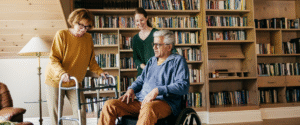In this article, we will discuss essential steps to help you plan for emergency medical situations, ensuring that all caregivers are well-prepared to handle any unexpected health crises. From creating a detailed emergency care plan to equipping your home with the necessary tools, we’ll cover everything you need to safeguard your loved one’s health in case of an emergency.
Steps to Take When Planning for Emergency Medical Situations:
Following these steps will save you and your loved one from difficult situations and help you better prepare for the unexpected.
1. Establish an Emergency Medical File:
One of the key preparations is to create a comprehensive emergency medical file. This file should include:
- Personal identification information (full name, date of birth, address).
- List of current medications (include dosage and frequency).
- Allergies (especially drug allergies)
- Medical conditions (e.g., heart disease, diabetes)
- Health insurance details
- Primary physician and specialists’ contact information
- Healthcare Power of Attorney or Advanced Healthcare Directives.
- Copy of a living will or Do Not Resuscitate (DNR) orders, if applicable.
Make sure this file is easily accessible to family members, caregivers, or emergency responders.
2. Create a Communication Plan:
- Identifying a key family contact who will be responsible for communicating with doctors and emergency personnel. This could be the person who holds healthcare power of attorney.
- Sharing contact details of family members or caregivers with doctors and medical facilities in advance.
- Creating a family group text or phone tree to quickly update relatives about the emergency.
- Having a language translation plan, if necessary, to ensure accurate communication during a medical emergency.
3. Keep Track of Your Loved One’s Medical History:
If you are caring for an elderly family member or someone with a chronic illness, having a deep understanding of their medical history is crucial. You should know:
- Symptoms and warning signs of their specific conditions (e.g., how to recognize a heart attack or stroke)
- Current treatment plans and any recent changes in medication or health status.
- Medical preferences and limitations (e.g., whether the individual prefers aggressive treatments or minimal interventions)
Discuss these details with your loved one’s primary care doctor regularly to stay up-to-date on their condition.
4. Advance Healthcare Directives:
Advance directives are legal documents that outline an individual’s preferences for healthcare, should they become unable to make decisions. This includes:
- Living wills, specify the type of medical care they wish to receive if incapacitated.
- Durable Power of Attorney for Healthcare, which appoints someone to make healthcare decisions on their behalf.
- DNR orders if your loved one opts not to have CPR or life-saving measures administered in specific situations.
It is essential to ensure that healthcare professionals, hospitals, and family members have copies of these documents to avoid confusion during an emergency.
5. Equip Your Home for Emergencies:
If you are caring for a loved one at home, equipping your living space for medical emergencies is essential. Some tips include:
- First Aid Kit: Ensure it’s fully stocked with essentials like bandages, antiseptics, pain relievers, emergency contact numbers, and emergency care providers.
- Medical Alert Systems: If your loved one is prone to falls or has conditions like heart disease, investing in a medical alert system can ensure they get help even when alone.
- Accessible Documentation: Keep emergency contact information and medical records in an easily accessible location (e.g., near the phone).
- Home Safety Measures: Install grab bars in the bathroom, remove trip hazards, and have clear access paths for emergency personnel.
Read More: 9 Common Home Safety Hazards and Their Practical Solutions
6. Prepare for Transportation Needs:
In an emergency, timing is crucial. Prepare for medical transportation by:
- Knowing the fastest route to the nearest hospital or emergency room.
- Arranging transportation options if you or the patient is unable to drive.
- Familiarize yourself with local ambulance services and understand when to call them versus driving to the hospital yourself.
Consider having a medical transport service on standby if your loved one has ongoing mobility challenges.
7. Regularly Review and Update the Emergency Plan:
Medical situations and personal preferences can change over time. It’s important to:
- Update medical files and advance directives regularly to reflect any changes in health conditions.
- Communicate changes with family members, caregivers, and doctors to ensure everyone is on the same page.
- Revisit home safety measures and first aid kit supplies periodically to ensure they are up-to-date.
What to Do If You Encounter a Medical Emergency?
Caregivers should remain calm and follow these steps to handle the situation professionally;
- Assess the situation.
- Call 911 or the local emergency number if the situation is life-threatening.
- Provide clear details to emergency responders about the individual’s condition.
- Administer basic first aid or follow instructions from the emergency dispatcher.
- Ensure the individual is comfortable and safe while waiting for help to arrive.
- Have quick access to the person’s medical records (e.g., conditions, medications, emergency contacts).
- Relay important medical information to emergency personnel upon their arrival.
- Document the incident and inform family members after the situation is under control.
Read More: How to Build Your Caregiver Skills Set?
We understand that medical emergencies can be overwhelming. Our caregivers are trained to handle urgent health situations with professionalism and care, providing peace of mind for families.
To Learn More:
If you want to learn how we can assist you in caring for your loved one and provide ongoing support, contact us today for a free consultation or reach out to us at wecare@considracare.com
Final Insights:
Planning for emergency medical situations can reduce panic, ensure that your loved one’s healthcare preferences are respected, and lead to faster, more efficient care. Preparing an emergency medical file, understanding the medical history of your loved ones, creating an advance directive, and reviewing these plans regularly are key steps in being ready for any medical emergency.
FAQ’S
1. What are the 5 steps in giving assistance to an emergency situation?
Stay calm, assess the situation, call for help, administer basic first aid if needed, and monitor the individual until help arrives.
2. What is the first step in creating an emergency medical plan?
The first step is gathering all essential medical information, including health conditions, medications, allergies, and emergency contacts.
3. How do I ensure caregivers are prepared for an emergency?
Provide caregivers with clear emergency protocols, medical information, and access to emergency contacts. Regular training in first aid is also helpful.
4. Who should wear medical alert jewelry?
Individuals with chronic conditions, severe allergies, or who are on life-saving medications should wear medical alert jewelry to inform responders in case of an emergency.





